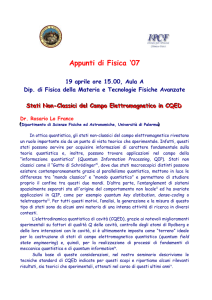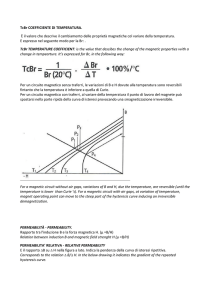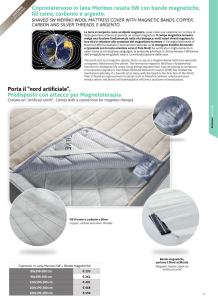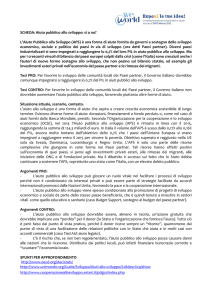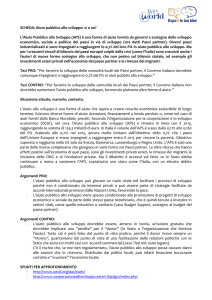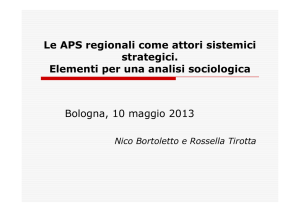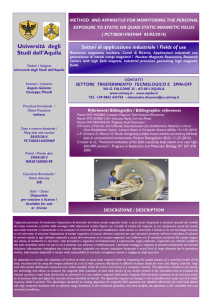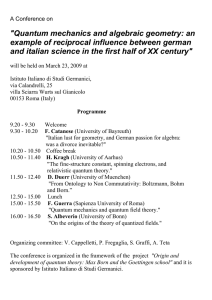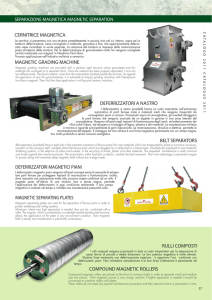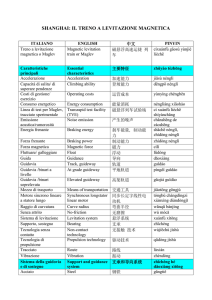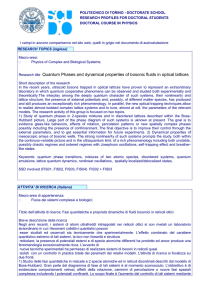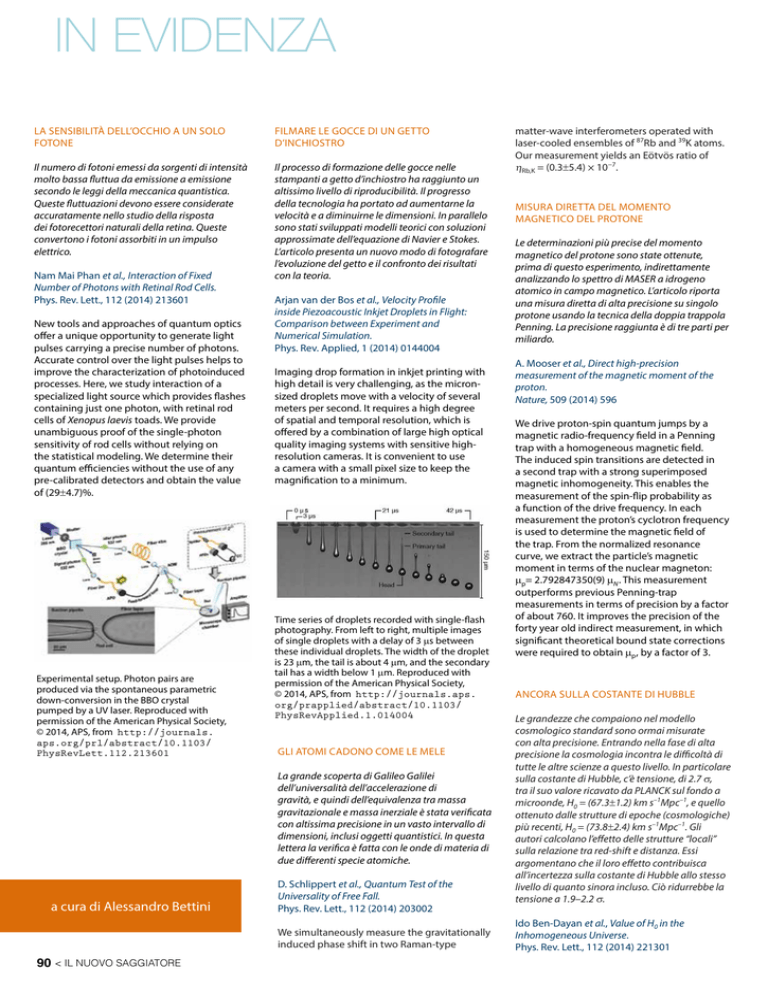
in evidenza
La sensibilità dell’occhio a un solo
fotone
Filmare le gocce di un getto
d’inchiostro
Il numero di fotoni emessi da sorgenti di intensità
molto bassa fluttua da emissione a emissione
secondo le leggi della meccanica quantistica.
Queste fluttuazioni devono essere considerate
accuratamente nello studio della risposta
dei fotorecettori naturali della retina. Queste
convertono i fotoni assorbiti in un impulso
elettrico.
Il processo di formazione delle gocce nelle
stampanti a getto d’inchiostro ha raggiunto un
altissimo livello di riproducibilità. Il progresso
della tecnologia ha portato ad aumentarne la
velocità e a diminuirne le dimensioni. In parallelo
sono stati sviluppati modelli teorici con soluzioni
approssimate dell’equazione di Navier e Stokes.
L’articolo presenta un nuovo modo di fotografare
l’evoluzione del getto e il confronto dei risultati
con la teoria.
Nam Mai Phan et al., Interaction of Fixed
Number of Photons with Retinal Rod Cells.
Phys. Rev. Lett., 112 (2014) 213601
New tools and approaches of quantum optics
offer a unique opportunity to generate light
pulses carrying a precise number of photons.
Accurate control over the light pulses helps to
improve the characterization of photoinduced
processes. Here, we study interaction of a
specialized light source which provides flashes
containing just one photon, with retinal rod
cells of Xenopus laevis toads. We provide
unambiguous proof of the single-photon
sensitivity of rod cells without relying on
the statistical modeling. We determine their
quantum efficiencies without the use of any
pre-calibrated detectors and obtain the value
of (29±4.7)%.
Experimental setup. Photon pairs are
produced via the spontaneous parametric
down-conversion in the BBO crystal
pumped by a UV laser. Reproduced with
permission of the American Physical Society,
© 2014, APS, from http://journals.
aps.org/prl/abstract/10.1103/
PhysRevLett.112.213601
Arjan van der Bos et al., Velocity Profile
inside Piezoacoustic Inkjet Droplets in Flight:
Comparison between Experiment and
Numerical Simulation.
Phys. Rev. Applied, 1 (2014) 0144004
Imaging drop formation in inkjet printing with
high detail is very challenging, as the micronsized droplets move with a velocity of several
meters per second. It requires a high degree
of spatial and temporal resolution, which is
offered by a combination of large high optical
quality imaging systems with sensitive highresolution cameras. It is convenient to use
a camera with a small pixel size to keep the
magnification to a minimum.
Time series of droplets recorded with single-flash
photography. From left to right, multiple images
of single droplets with a delay of 3 μs between
these individual droplets. The width of the droplet
is 23 μm, the tail is about 4 μm, and the secondary
tail has a width below 1 μm. Reproduced with
permission of the American Physical Society,
© 2014, APS, from http://journals.aps.
org/prapplied/abstract/10.1103/
PhysRevApplied.1.014004
Gli atomi cadono come le mele
La grande scoperta di Galileo Galilei
dell’universalità dell’accelerazione di
gravità, e quindi dell’equivalenza tra massa
gravitazionale e massa inerziale è stata verificata
con altissima precisione in un vasto intervallo di
dimensioni, inclusi oggetti quantistici. In questa
lettera la verifica è fatta con le onde di materia di
due differenti specie atomiche.
a cura di Alessandro Bettini
D. Schlippert et al., Quantum Test of the
Universality of Free Fall.
Phys. Rev. Lett., 112 (2014) 203002
We simultaneously measure the gravitationally
induced phase shift in two Raman-type
90 < il nuovo saggiatore
matter-wave interferometers operated with
laser-cooled ensembles of 87Rb and 39K atoms.
Our measurement yields an Eötvös ratio of
ηRb,K = (0.3±5.4) × 10−7.
Misura diretta del momento
magnetico del protone
Le determinazioni più precise del momento
magnetico del protone sono state ottenute,
prima di questo esperimento, indirettamente
analizzando lo spettro di MASER a idrogeno
atomico in campo magnetico. L’articolo riporta
una misura diretta di alta precisione su singolo
protone usando la tecnica della doppia trappola
Penning. La precisione raggiunta è di tre parti per
miliardo.
A. Mooser et al., Direct high-precision
measurement of the magnetic moment of the
proton.
Nature, 509 (2014) 596
We drive proton-spin quantum jumps by a
magnetic radio-frequency field in a Penning
trap with a homogeneous magnetic field.
The induced spin transitions are detected in
a second trap with a strong superimposed
magnetic inhomogeneity. This enables the
measurement of the spin-flip probability as
a function of the drive frequency. In each
measurement the proton’s cyclotron frequency
is used to determine the magnetic field of
the trap. From the normalized resonance
curve, we extract the particle’s magnetic
moment in terms of the nuclear magneton:
mp= 2.792847350(9) mN . This measurement
outperforms previous Penning-trap
measurements in terms of precision by a factor
of about 760. It improves the precision of the
forty year old indirect measurement, in which
significant theoretical bound state corrections
were required to obtain mp , by a factor of 3.
Ancora sulla costante di Hubble
Le grandezze che compaiono nel modello
cosmologico standard sono ormai misurate
con alta precisione. Entrando nella fase di alta
precisione la cosmologia incontra le difficoltà di
tutte le altre scienze a questo livello. In particolare
sulla costante di Hubble, c’è tensione, di 2.7 s,
tra il suo valore ricavato da PLANCK sul fondo a
microonde, H0 = (67.3±1.2) km s–1Mpc–1, e quello
ottenuto dalle strutture di epoche (cosmologiche)
più recenti, H0 = (73.8±2.4) km s–1Mpc–1. Gli
autori calcolano l’effetto delle strutture “locali”
sulla relazione tra red-shift e distanza. Essi
argomentano che il loro effetto contribuisca
all’incertezza sulla costante di Hubble allo stesso
livello di quanto sinora incluso. Ciò ridurrebbe la
tensione a 1.9–2.2 s.
Ido Ben-Dayan et al., Value of H0 in the
Inhomogeneous Universe.
Phys. Rev. Lett., 112 (2014) 221301

